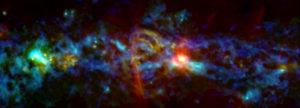 “A feature resembling a candy cane appears at the center of this colorful composite image of our Milky Way galaxy’s central zone. But this is no cosmic confection. Reaching 190 light-years tall, it is one of a set of long, thin, radio-emitting filaments, discovered by Northwestern University’s Farhad Yusef-Zadeh in the early 1980s.
“A feature resembling a candy cane appears at the center of this colorful composite image of our Milky Way galaxy’s central zone. But this is no cosmic confection. Reaching 190 light-years tall, it is one of a set of long, thin, radio-emitting filaments, discovered by Northwestern University’s Farhad Yusef-Zadeh in the early 1980s.
This particular candy cane-shaped filament was recently detected by the Goddard-IRAM Superconducting 2-Millimeter Observer (GISMO), designed and built at NASA’s Goddard Space Flight Center in Greenbelt, Maryland. It marks the first time that astrophysicists have observed these structures with two-millimeter wavelengths…”
Read the full Northwestern Now article here.

